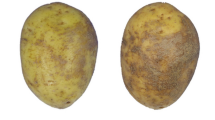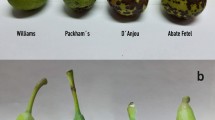Abstract
The aim of the research was (i) to evaluate white and cream strains of A. bisporus yields when challenged or not with the pathogen L. fungicola, (ii) to identify the more aggressive pathogen isolates, and (iii) to develop a diagrammatic scale of spot symptoms on infected mushrooms. The experiment was carried out using two strains of A. bisporus (white and cream strains, ABI 19/01 and PB 19/01, respectively) and four isolates of L. fungicola (LF 19/01, FL 19/02, LF 19/03, and LF 19/04). The A. bisporus white strain (ABI 19/01) reached a higher yield of healthy mushrooms compared to the cream strain (PB 19/01) with values of 23.8 and 14.1%, respectively. The LF 19/03 pathogen was most aggressive, reducing the yield of healthy mushrooms by up to 64% for the PB 1/01 strain, and 49.6% for the ABI 19/01 strain. Additionally, for the same isolate, larger mushroom areas were affected, while also displaying symptoms precociously during the second flush. Finally, using the set of visually displayed symptoms assessed in this study, we were able to construct a diagrammatic scale to assist commercial mushroom growers for managing diseased crops.




Similar content being viewed by others
References
Buth J (2017) Compost as a food base for Agaricus bisporus. In: Zied DC, Pardo-Giménez A (eds) Edible and medicinal mushrooms: Technology and applications, 1st edn. Wiley, Chichester, UK, pp 129–147
Letti LAJ, Vítola FMD, Pereira GV, Karp SG, Medeiros ABP, Ferreira da Costa ES, Bissoqui L, Soccol CR (2018) Solid-state fermentation for the production of mushrooms. In: Pandey A, Larroche C, Soccol CR (eds) Current Developments in Biotechnology and Bioengineering. Elsevier BV, Amsterdam, pp 285–318
Zied DC, Nunes JS, Nicolini VF, Pardo-Giménez A, Rinker DL, Dias ES (2015) Tolerance to Lecanicillium fungicola and yield of Agaricus bisporus strains used in Brazil. Sci Hortic 190:117–122. https://doi.org/10.1016/j.scienta.2015.04.021
Dhar BL (2017) Mushrooms and human civilization. In: Zied DC, Pardo-Giménez A (eds) Edible and medicinal mushrooms: Technology and applications, 1st edn. Wiley, Chichester, UK, pp 1–4
Pardo-Giménez A, Pardo-González JE, Zied DC (2017) Casing materials and techniques in Agaricus bisporus cultivation. In: Zied DC, Pardo-Giménez A (eds) Edible and medicinal mushrooms: Technology and applications, 1st edn. Wiley, Chichester, UK, pp 149–163
Stanojević O, Berić T, Potočnik I, Rekanović E, Stanković S, Milijašević-Marčić S (2019) Biological control of green mould and dry bubble diseases of cultivated mushroom (Agaricus bisporus L.) by Bacillus spp. Crop Prot. 126: 104944. Doi: 10.1016/j.cropro.2019.104944
McGee CF, Byrne H, Irvine A, Wilson J (2017) Diversity and dynamics of the DNA- and cDNA-derived compost fungal communities throughout the commercial cultivation process for Agaricus bisporus. Mycologia 109(3):475–484. https://doi.org/10.1080/00275514.2017.1349498
Gea FJ, Carrasco J, Diánez F, Santos M, Navarro MJ (2014) Control of dry bubble disease (Lecanicillium fungicola) in button mushroom (Agaricus bisporus) by spent mushroom substrate tea. Eur J Plant Pathol 138:711–720. https://doi.org/10.1007/s10658-013-0344-y
Fletcher JT, White PF, Gaze RH (1986) Mushrooms: Pest and disease control. Intercept, Newcastle upon Tyne
Ware WMA (1933) Disease of cultivated mushrooms caused by Verticillium malthousei sp nov. Ann Bot 47(4):763–784
Berendsen RL, Baars JJ, Kalkhove SI, Lugones LG, Wösten HA, Bakker PA (2010) Lecanicillium fungicola: causal agent of dry bubble disease in white-button mushroom. Mol Plant Pathol 11:585–595. https://doi.org/10.1111/j.1364-3703.2010.00627.x
ML, Savoie JM, 2010 Microbial-induced diseases of Agaricus bisporus: biochemical mechanisms and impact on commercial mushroom production (mini-review) Appl Microbiol Biotechnol 86 63 73 10.1007/s00253-010-2445-2
Gea FJ, Tello JC, Honrubia M (1996) In vitro sensitivity of Verticillium fungicola to selected fungicides. Mycopathologia 136(3):133–137
Zare R, Gams W (2008) A revision of the Verticillium fungicola species complex and its affinity with the genus Lecanicillium. Mycol Res. 112:811–824. https://doi.org/10.1016/j.mycres.2008.01.019
Zied DC, Minhoni MTA, Kopytowski-Filho J, Andrade MCN (2010) Production of Agaricus blazei ss. Heinemann (A. brasiliensis) on different casing layers and environments. World J Microbiol Biotechnol 26:1857–1863. https://doi.org/10.1007/s11274-010-0367-x
Lyons GA, Sharma HS, Kilpatrick M, Cheung L, Moore S (2006) Monitoring of changes in substrate characteristics during mushroom compost production. J Agr Food Chem 54:4658–4667. https://doi.org/10.1021/jf052934i
Gea FJ, Tello J (1997) Micosis del cultivo del champiñón. Mundi-Prensa, Madrid
Gea FJ, Tello JC, Navarro MJ (2003) Occurrence of Verticillium fungicola var. Fungicola on Agaricus bitorquis Mushroom Crops in Spain. J Phytopathol 151:98–100. https://doi.org/10.1046/j.1439-0434.2003.00687.x
Hammond JBW, Nichols R (1976) Carbohydrate metabolism in Agaricus bisporus (Lange) Sing.: changes in soluble carbohydrates during growth of mycelium and sporophore. J Gen Microbiol 93:309–320. https://doi.org/10.1099/00221287-93-2-309
Pardo-Giménez A, Pardo-González JE, Zied DC (2011) Evaluation of harvested mushroom and viability of Agaricus bisporus growth using casing materials made from spent mushroom substrate. Int J Food Sci Technol 46(4):787–792. https://doi.org/10.1111/j.1365-2621.2011.02551.x
Spósito MB, Amorim L, Belasque Junior J, Bassanezi RB, Aquino RD (2004) Elaboration and validation of diagrammatic scale to evaluate black spot severity in citrus fruits. Fitopatologia Brasileira 29(1):81–85. https://doi.org/10.1590/S0100-41582004000100012
Largeteau ML, Savoie JM (2008) Effect of the fungal pathogen Verticillium fungicola on fruiting initiation of its host, Agaricus bisporus. Mycol Res 112(7):825-828. https://doi.org/10.1016/j.mycres.2008.01.018
Piasecka J, Kavanagh K, Grogan H (2011) Detection of sources of Lecanicillium (Verticillium) fungicola on mushroom farms. Mushroom Biology and Mushroom Products 7. WSMBMP, Arcachon, France, pp 484–489
Gea FJ, Carrasco J, Diánez F, Santos M, Navarro MJ (2013) Incidence of Lecanicillium fungicola in white-button mushroom (Agaricus bisporus) cultivated with two types of casing soil. J Plant Pathol 95(1):163–166. https://doi.org/10.4454/JPP.V95I1.014
Patyshakuliyeva A, Jurak E, Kohler A, Baker A, Battaglia E, de Bruijn W, Burton KS, Challen MP, Coutinho PM, Eastwood DC, Gruben BS, Mäkelä MR, Martin F, Nadal M, van den Brink J, Wiebenga A, Zhou M, Henrissat B, Kabel M, Gruppen H, de Vries RP (2013) Carbohydrate utilization and metabolism is highly differentiated in Agaricus bisporus. BMC Genomics 14(1):663. https://doi.org/10.1186/1471-2164-14-663
Patyshakuliyeva A, Post H, Zhou M, Jurak E, Heck AJR, Hildén KS, Kabel MA, Mäkelä MR, Altelaar MAF, de Vries RP (2015) Uncovering the abilities of Agaricus bisporus to degrade plant biomass throughout its life cycle. Environ Microbiol 17(8):3098–3109. https://doi.org/10.1111/1462-2920.12967
McGee CF (2018) Microbial ecology of the mushroom cropping process. Appl Microbiol Biotechnol 102:1075–1083. https://doi.org/10.1007/s00253-017-8683-9
Sánchez JE, Zied DC, Albertó E (2018) Edible mushroom production in the Americas. Mushroom Biology and Mushroom Products 9. WSMBMP, Shanghai, China, pp 2–11
North LH, Wuest PJ (1993) The infection process and symptom expression of Verticillium disease of Agaricus bisporus. Can J Plant Pathol 15:74–80. https://doi.org/10.1080/07060669309500829
Foulongne-Oriol M, Rodier A, Rousseau T, Largeteau M, Savoie JM (2011) Quantitative genetics to dissect the fungal-fungal interaction between Lecanicillium verticillium and the white button mushroom Agaricus bisporus. Fungal Biol 115:421–431. https://doi.org/10.1016/j.funbio.2011.02.017
Burritt RL, Herzig C, Schaltegger S, Viere T (2019) Diffusion of environmental management accounting for cleaner production: Evidence from some case studies. J Clean Prod 224:479–491. https://doi.org/10.1016/B978-012088441-4/50015-0
Author information
Authors and Affiliations
Contributions
DCZ conceived and designed the study; CECC, MRI, and WGV carried out experimental work; DCZ, AP, and ESD carried out the analysis and interpretation of data, statistical analysis, and technical support; DCZ and CECC co-wrote the manuscript; DCZ, AP, and ESD supervised the work and reviewed the manuscript.
Corresponding author
Additional information
Publisher's Note
Springer Nature remains neutral with regard to jurisdictional claims in published maps and institutional affiliations.
Rights and permissions
About this article
Cite this article
Caitano, C.E.C., Iossi, M.R., Pardo-Giménez, A. et al. Design of a Useful Diagrammatic Scale for the Quantification of Lecanicillium fungicola Disease in Agaricus bisporus Cultivation. Curr Microbiol 77, 4037–4044 (2020). https://doi.org/10.1007/s00284-020-02232-8
Received:
Accepted:
Published:
Issue Date:
DOI: https://doi.org/10.1007/s00284-020-02232-8




